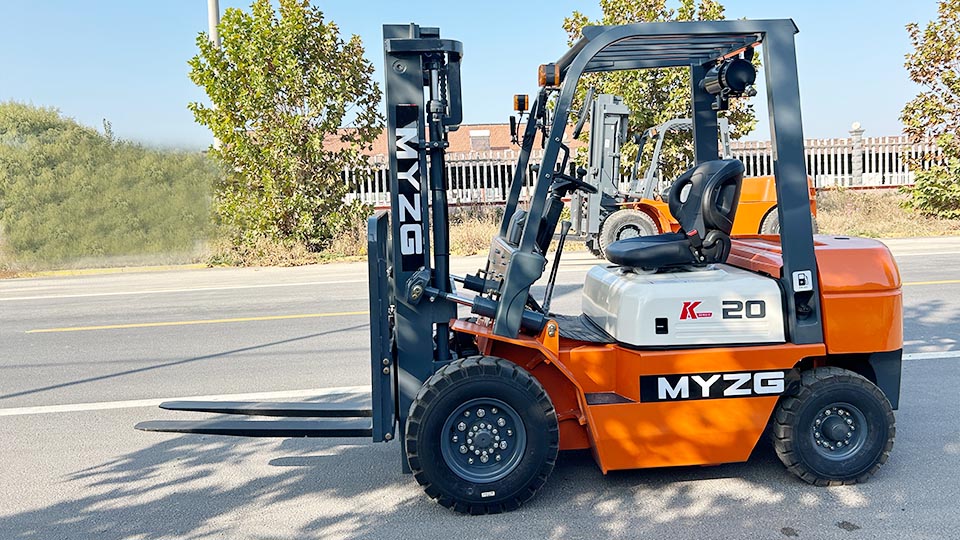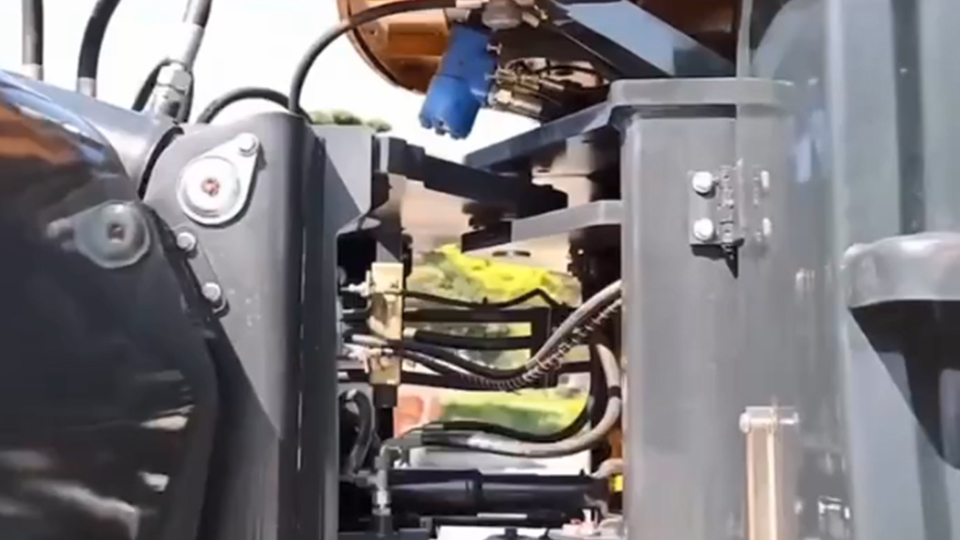
The Forklift Mast: An Analysis of Structure, Mechanics, and Hydraulic Function
The mast assembly is a highly engineered subsystem of the Powered Industrial Truck (PIT), specifically designed to translate the power from the engine or electric motor into controlled vertical motion. Its design directly dictates the lifting capacity, maximum height, and overall stability of the forklift.3 Functionally, the mast acts as a multi-stage, telescopic column that manages immense compressive and shear forces while maintaining geometric precision for safe load handling.4
I. Structural and Mechanical Components of the Mast
A typical forklift mast is built from high-strength structural steel rails, which house the various mechanical and hydraulic components.5 Its core functionality relies on the interaction of four main parts: the uprights, the carriage, the lift cylinders, and the lift chains.6
1. The Uprights (Rails)
The uprights are the vertical members, or channels, that form the telescopic structure of the mast. These rails are often nested, allowing the mast to extend its height without increasing its retracted size significantly.7
Fixed Upright: The outermost, non-moving section bolted directly to the forklift chassis. It provides the foundational support and houses the primary hydraulic lift cylinder(s).

Moving Upright(s): One or more inner channels that slide within the fixed upright. The most common configuration is a two-stage (duplex) or three-stage (triplex) design, although specialized quad masts (four-stage) are used for extreme lift heights.
Rollers and Wear Pads: Precision rollers are mounted to the moving uprights and the carriage.8 These rollers ride within the channels to guide the movement, minimize friction, and ensure stability under load. Wear pads are replaceable, low-friction materials used in areas where metal-to-metal contact occurs, protecting the structural integrity of the rails.
2. The Carriage Assembly
The carriage is the horizontal component that moves up and down the mast rails, serving as the mounting point for the forks and any attachments. It is a critical link, transferring the load directly into the mast structure.
Fork Mount: The standard configuration uses a hook-type or shaft-type carriage, conforming to ISO or ITA (Industrial Truck Association) standards. This design allows quick, secure mounting of different fork lengths and attachments.
Side-Shifter: A common, non-standard attachment often integrated into the carriage.9 It allows the operator to shift the forks (and the load) horizontally left or right, typically up to 4 inches, without repositioning the entire truck. This is crucial for precise load placement and retrieving loads in tight racking.
Load Backrest Extension (LBR): A vertical extension of the carriage assembly that extends upward to prevent the load (or parts of the load) from shifting backward, particularly when the mast is tilted or the load is uneven.
3. The Lift Cylinders and Hydraulic System
The mast's power derives from the hydraulic system.10 The system uses a gear or vane pump, driven by the forklift's engine or motor, to pressurize hydraulic fluid (typically mineral oil) and drive the lift and tilt cylinders.11
Lift Cylinders (Hoisting):
Primary Cylinder (Free Lift): A large-bore cylinder, often mounted centrally, which directly lifts the carriage on a chain linkage. On full free-lift masts (triplex/quad), this cylinder is often telescopic itself, allowing the carriage to lift the load a certain distance (known as free lift) before the inner mast rails begin to extend.12 This is essential for operating inside enclosed spaces like containers or low-ceiling warehouses.
Secondary Cylinders (Telescoping): Used in two-stage and higher masts, these cylinders are activated after the initial lift to extend the inner uprights, achieving the truck's maximum height.
Tilt Cylinders: Two separate, smaller-bore hydraulic cylinders mounted low on the chassis. They connect to the base of the mast to control the mast's fore and aft angular position.
Forward Tilt: Typically limited to a few degrees (e.g., $3^\circ$ to $6^\circ$) for load engagement and placement.
Backward Tilt (Load Stability): Typically 13$10^\circ$ to 14$15^\circ$ to cradle the load against the load backrest during transport, significantly enhancing longitudinal stability.15

4. Lift Chains
High-tensile steel leaf chains are the mechanical link between the hydraulic cylinder rod and the carriage assembly.
Reeving Ratio: The chains are "reeved" over sprockets or sheaves, often with a $2:1$ ratio. This means for every $1$ unit of extension of the hydraulic cylinder rod, the carriage and forks move $2$ units vertically. This mechanical advantage allows the use of smaller, less powerful hydraulic cylinders to achieve a greater lift height and speed.
Technical Importance: Chains are a high-wear component and are critical safety items.16 Regulatory requirements mandate regular inspection for wear, corrosion, and proper tensioning.
II. Classification of Mast Types
Masts are classified primarily by the number of stages (or channels) they use and their Free Lift capability. Free lift is the distance the forks can be raised before the overall height of the mast structure begins to increase.17 This is a crucial technical specification for operations involving stacking inside closed containers, truck trailers, or in areas with low overhead clearance.
1. Simplex (Single-Stage) Mast (M)
Structure: One fixed upright rail and one primary lift cylinder.
Operation: The forks travel up the rail on the carriage. The chain reeving is often $2:1$.
Free Lift: None. The primary cylinder begins to extend the carriage immediately, meaning the mast's overall height begins to increase as soon as the forks leave the ground.
Application: Simple, durable, often used in outdoor yards or areas where overhead clearance is not a concern.
2. Duplex (Two-Stage) Mast (D)
Structure: One fixed upright and one moving upright rail.
Operation: The carriage lifts on the chain.18 Once the carriage reaches the top of the fixed rail, the secondary cylinder activates to extend the moving rail.
Free Lift: Partial. It typically provides only a small amount of free lift (e.g., 6 to 12 inches) before the first moving stage begins to raise.
Application: General-purpose warehousing where some, but not extreme, overhead clearance is needed.
3. Triplex (Three-Stage) Mast (T)
Structure: One fixed upright and two moving upright rails.
Operation: Utilizes a central, telescopic cylinder that provides the initial full free lift.19 The carriage lifts the full distance of this initial cylinder extension before the second and third mast stages begin to extend sequentially.
Free Lift: Full Free Lift. The forks can lift the load to nearly the height of the retracted mast before the uprights begin to extend.
Application: The most common design for indoor warehousing. Essential for loading and unloading standard truck trailers or ocean containers, as it allows the operator to stack loads inside without hitting the ceiling or upper door frame.
4. Quadplex (Four-Stage) Mast (Q)
Structure: One fixed upright and three moving upright rails.
Operation: Similar to the Triplex, but adds a fourth stage for extreme lift heights, using more complex hydraulic reeving.
Free Lift: Full Free Lift.
Application: Very high-bay warehouse operations where stacking loads above 20 feet is required, but still offers the flexibility of full free lift.
III. Key Performance Metrics and Stability Physics
The mast is central to the two most important technical specifications of any forklift: Lifting Capacity and Stability.
1. Rated Capacity and the Data Plate
Every forklift mast assembly is structurally rated to a maximum load, specified on the data plate (also known as the capacity plate or nameplate). This plate is a legally required document detailing the vehicle’s safe operating limits.
Rated Capacity (C): The maximum weight (in pounds or kilograms) the forklift can safely lift.
Load Center (L): The horizontal distance from the front face of the forks to the center of gravity of the load. Standard capacity ratings are typically based on a 24-inch (600 mm) load center.
Derating: When a specialized attachment (e.g., a clamp) is added, or when the load center is extended beyond the standard 24 inches, the truck's overall rated capacity is derated (reduced) to maintain stability.20 The mast structure itself is subject to increased bending and shear stresses under derated conditions.
2. The Stability Triangle
The safe operation of the mast is governed by the principles of static equilibrium, specifically the stability triangle.
Concept: For a four-wheel counterbalanced forklift, the chassis rests on a three-point suspension system, defining a zone of stability on the ground.21 The two front wheels form the base, and the pivot point of the steer axle forms the apex.
The Role of the Mast: As the mast lifts a load, the combined center of gravity (CG) of the truck and the load shifts forward and upward.22 If the CG moves outside the stability triangle, the forklift will tip over longitudinally (forward).23 The backward tilt capability of the mast is critical for drawing the load closer to the CG of the truck, moving the combined CG rearward and downward for safe transport. Conversely, when the mast is tilted forward during placement, the operator must be stationary, as the CG is momentarily shifted to its most unstable position.
IV. Technical Inspection and Maintenance
Because the mast operates under high pressure and significant mechanical stress, regular technical inspection and maintenance are mandatory, governed by standards such as OSHA 29 CFR 1910.178.
Hydraulic System Integrity:
Cylinder Leaks: Inspection for leaks around rod seals and hose connections.24 A loss of hydraulic fluid pressure can compromise lifting capacity and control.25
Hose Wear: Checking high-pressure hydraulic hoses for chaffing, abrasions, or ballooning, which are indicators of imminent failure.
Chain Inspection:
Elongation: Chains are checked for stretch or elongation, typically using a specialized gauge.26 Excessive elongation indicates wear on the link pins and sprockets, severely compromising chain strength.27
Corrosion/Damage: Visual inspection for rust, cracked links, or missing cotter pins. Failed lift chains are a primary cause of catastrophic load drop accidents.
Structural Components and Carriage:
Roller Play: Checking for excessive side-to-side play or looseness in the mast rails and carriage rollers. Loose rollers lead to instability, misalignment, and uneven wear on the rails, reducing the precision required for high stacking.
Weld Integrity: Inspection of all structural welds on the mast frame and carriage for cracks or stress fractures, which are common points of failure in high-cycle, high-stress environments.28
V. Specialization and Advanced Mast Designs
While the counterbalance truck's mast is the most common, other PIT classes utilize variations with advanced mechanical features:
Reach Truck Masts: Used in narrow-aisle trucks, the mast is mounted to a pantograph mechanism or rails that allow the entire mast assembly to "reach" forward beyond the stabilizing outriggers to pick up or place a load. The load is then retracted back within the footprint of the outriggers for safe travel.
Articulated Mast (VNA Trucks): Very Narrow Aisle (VNA) forklifts, such as Turret Trucks, use a mast that can rotate $90^\circ$ and traverse (side-shift) the forks. This allows the truck to pick or place loads on either side of a very narrow aisle without turning the main chassis.
Telescopic Handlers (Telehandlers): These non-counterbalance machines use a multi-stage telescopic boom instead of a vertical mast. The boom is driven by a massive, multi-stage hydraulic cylinder that extends the boom outward and upward, often for construction or rough-terrain lifting, where stability is managed by outriggers and a complex load management system rather than rear counterweight.
In conclusion, the mast is the technical heart of the forklift. It is a sophisticated blend of hydraulics, structural engineering, and precision mechanics that allows the machine to overcome gravity and kinetic forces to manage the three-dimensional movement of heavy loads.29 The safe and effective operation of any PIT fundamentally relies on the structural integrity and precise function of its mast assembly.
Name: selena
Mobile:+86-13176910558
Tel:+86-0535-2090977
Whatsapp:8613181602336
Email:vip@mingyuforklift.com
Add:Xiaqiu Town, Laizhou, Yantai City, Shandong Province, China